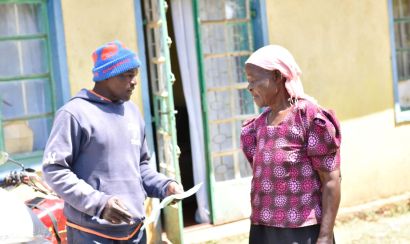Calling For A Distribution Revolution
Stephanie Hanson is senior vice president of policy and partnerships at One Acre Fund. This post originally appeared on the Farming First website.
The day she received her fertilizer delivery, Rwandan smallholder farmer Anonciata Mbakirirehe couldn’t help but smile. She was one of over 40 farmers who met at a village in Kayenzi, Rwanda, to receive fertilizer delivered within walking distance of their homes. The delivery was organized by One Acre Fund, which provides seed and fertilizer on credit to 200,000 smallholder farmers in Kenya, Rwanda, Burundi, and Tanzania.
Every year, One Acre Fund hires fleets of trucks to deliver tens of thousands of metric tons of seed and fertilizer to hundreds of villages like the one Anonciata visited in Kayenzi. Delivery of farm inputs must be planned months in advance so that they arrive in time for planting. It involves hundreds of staffers who are responsible for tasks ranging from input procurement to warehouse logistics.
The distribution of seed and fertilizer is the most logistically complex part of our four-part operating model. Yet without distribution, the other parts of the model—financing, training, and market facilitation—would not produce meaningful dollar impact for smallholder farmers.

We believe the delivery of simple, life-changing technologies directly to smallholder farmers at the village level is the next great frontier in agriculture innovation. Farmers like Anonciata often live miles away from the nearest town and market center. The transportation costs to travel to that town and bring back fertilizer are often prohibitive. Farmers must also weigh the uncertainty of whether local shops in that town will have any seed and fertilizer in stock, let alone high-quality seed and fertilizer.
Simply put, the science that farmers in the United States or Europe have had access to for decades just isn’t reaching smallholder farmers. As a result, they are unable to feed themselves, their families, or their communities. Farm families experience annual seasons of hunger and meal skipping. Children in sub-Saharan Africa are more than 15 times more likely to die before the age of five than children in developed regions, many from malnutrition-related causes.
In sub-Saharan Africa, nearly 65% of people depend on farming as their primary source of income. Smallholder farmers need to improve their agriculture productivity to address world hunger. In order to improve productivity, they need access to improved seed and fertilizer.
That is why we’re calling for a distribution revolution. One Acre Fund’s rural distribution model is one effective way to address global hunger. But given the magnitude of the challenge, we know that we need many different distribution models.
What would help spur a distribution revolution?
African governments have committed to dedicate 10 percent of their national budgets to agriculture. They should allocate a modest amount of that funding to supporting businesses that distribute agriculture technologies to smallholder farmers.
The global agriculture research community is fantastic at generating new agriculture innovations. If it allocated even five percent of its resources to developing new distribution methods, that could produce valuable new innovations to deliver life-changing products directly into the hands of smallholder farmers.
Finally, an innovation fund would incentivize more of the world’s great minds to invest their brainpower to develop creative last-mile distribution mechanisms. The Global Fund, created in 2002 to help governments and organizations implement programs and distribute medical supplies to fight HIV, Tuberculosis and Malaria, or D-Prize, which funds social entrepreneurs whose early stage start-ups aim to distribute effective poverty alleviation solutions, are two good models to consider.
The Global Fund and D-Prize work because they benefit from private sector buy-in. For seed and fertilizer companies, distribution costs are still too high to reach rural farmers who live in remote areas. In spite of high demand for their products, the problem of distribution is considered too great a barrier.

A distribution revolution will require a shift in the way the business world thinks about smallholder farmers. At One Acre Fund, we’ve seen that as farmers increase their productivity and incomes, their purchasing power increases. They choose to invest in productive assets, such as livestock or small greenhouses for growing vegetables, and are able to send their children to secondary school. Anonciata chose to invest in more land to plant, with the hope of increasing her harvest surplus.
Africa’s smallholder farmers are entrepreneurs, and the continent’s largest untapped market. If we can innovate cost-effective, scalable ways to distribute agriculture technologies to the millions of smallholder farmers who demand them, we will unlock a huge market opportunity—and our best chance to feed the world.
Want to learn more about the Distribution Revolution? Watch this video-interview with Stephanie Hanson, senior vice president of policy and partnerships, One Acre Fund.





